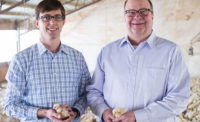Cover Story
Tyson Foods' Storm Lake storms back
After a fire destroyed a significant portion of its processing space in March 2014, Hillshire Brands’ Storm Lake, Iowa, plant (now owned by Tyson Foods) charged ahead, rebuilt and got back to processing turkeys in less than a year.

Ray Team and Russ Dierenfield, Poultry Division-Turkey Operations, Tyson Foods, display the local newspaper's headline news from the day that the Storm Lake, Iowa, turkey-processing plant reopened its doors after a fire destroyed a portion of the facility in March 2014.

Russ Dierenfield, Tyson Foods, and Andy Hanacek, The National Provisioner, begin their tour of the new dark-meat room at the company's Storm Lake, Iowa, turkey-processing plant, discussing the brand new chiller towering over them in the background.






Photos by Andy Hanacek and courtesy of Tyson Foods
It stands as one of the more frightening calls a plant or operations manager ever could receive: “We have a fire at the plant.”
Russ Dierenfield, sr. manager, Plant & Farm Operations, for the Poultry Division-Turkey Operations of Hillshire Brands (now Tyson Foods) in Storm Lake, Iowa, got that very call as he was returning from a trip to central Iowa with his family on March 22, 2014. The sanitation manager who called did not know the severity of the fire at the time, but as Dierenfield began notifying other personnel who were in town, signs began to show a disaster unfolding.
“It wasn’t 10 minutes later that there were already photos being posted on Facebook, and so my wife handed it to me and said, ‘Take a look at this,’” he recalls. “There were flames shooting out above the building [in the photos]. Then, I happened to look up at the horizon — we were still 45 minutes away — and I could see smoke already.”
Meanwhile, Ray Team, director, Group Manufacturing for the Poultry Division-Turkey Operations, was headed to the plant after Dierenfield had called him. By the time he’d gotten within three-quarters to a half mile from the plant, he could see the flames shooting out of the top of the facility. He immediately went to the fire command center to assist as needed.
“It was more than three or four hours during which the flames were 30 or 40 feet above the roofline, and then we still had smaller fires on and off at 3 or 4 a.m. — hotspots that they were still trying to put out,” Team says. Soon after, Dierenfield and the plant manager suited up in safety gear and accompanied the fire department into the plant to inspect the damage and check on a few locked areas.
“I knew, immediately, walking in the front door, that it wasn’t good. [The offices had] a lot of smoke and water damage, and our first comment was, ‘We won’t be running tomorrow or even next week,’” he says. “We knew it was bad, but you don’t really know the severity until you actually get in there and see everything that was melted, twisted and turned, and you actually see the roof had collapsed in some areas.”
Fortunately, there were no injuries, Team says, and he and the plant employees are thankful for the community’s efforts as well.
“Storm Lake first responders did a great job helping us and we’re very grateful for their efforts,” he says. “We also received an outpouring of support and offers of help from others in the community.”
The cause of the fire was eventually determined to be a welding accident, and it had started in an internal wall in the oldest portion of the plant — building construction that dated back to the late 1950s. The entire evisceration and dark-meat processing room was destroyed, but the fire did not spread to the newer areas of the plant, including the white-meat room, the dry storage or the freezers. However, Team says, there was smoke and debris spread throughout the entire facility.
Once the fire was out, it wasn’t long before assessments were made by the Hillshire local and corporate teams. From the start, it became apparent to the Storm Lake group that rebuilding was priority No. 1.
“I left the plant at 5:30 in the morning on Sunday, and Ray and I were already heading to the airport at 7:30 to pick up our corporate management,” Dierenfield says. “The cleanup couldn’t start immediately, as we had to wait for the fire marshal and insurance to come in, but the amount of days we were at a standstill was small.”
Fortunately, the necessary pause on facility cleanup allowed the Storm Lake team to focus on two more important quandaries: What to do with the employees and what to do with the turkeys that were already in the supply chain, scheduled to be processed at the facility?
Team, Dierenfield and the rest of the Hillshire management involved in getting turkeys shipped, processed and returned to Storm Lake’s sister facilities remain extremely thankful to the turkey industry for its assistance throughout the fire recovery and reconstruction. Team says nearly every turkey processor assisted them in some way, minimizing any disruption the disaster might have caused.
As the first cleanup and construction crews began the extensive work to put the plant back together, Team called all plant employees to a meeting, where he relayed the news from corporate.
“By Tuesday, we already had the decision made … that they would be paid a full 40 hours while we were offline, along with their benefits continuing — we’re going to rebuild and we’re going to pay you while you’re off,” Team says. “We had the employees come in and get their checks so that we could keep in contact with them, and periodically, we would have meetings so that we could update them on what was going on.”
Employees were not required to sign any sort of agreements to stay with the plant, and Team says that any of them could have resigned at any time without having to forfeit any of the pay or benefits given during the plant’s reconstruction. The testament to the loyalty built up over the decades, he says, comes from the fact that more than 90 percent of the pre-fire workforce returned — despite having several processing and manufacturing work options spread throughout the region.
Even a potential monkeywrench — the pursuit and acquisition of Hillshire Brands by Tyson Foods — didn’t slow momentum in Storm Lake. In fact, during the bidding war and waiting period after it was announced that Tyson would be acquiring Hillshire, plant management kept employees informed and spirits up.
“We tried to instill in them that this would be a great facility no matter what happened through the process, and we felt confident that we would continue to rebuild too,” Dierenfield explains. “We’re going to be a great facility, we’re going to be set up for a number of years, and we’re going to do a great job for whoever might own the plant.”
Reconstruction of the plant carried on through the summer and early fall, and as progress sped along, it soon became time to look at startup dates and preparing employees to re-enter the workforce, Team explains. A customized work-hardening program was developed by the Storm Lake plant management and the local hospital, Buena Vista Regional Medical Center, and began six weeks prior to the anticipated restart of the plant (see “Get more of the story online ...” box on page 22 for link to video).
“The nice thing is, [the medical center] developed our daily exercise program, so they understood what the jobs were and how we were going to ramp back up, and they did a nice job developing the program,” Dierenfield says.
With plans enacted to keep turkey processing moving and employees happy but prepared to return to work, it was time to assess the reconstruction of the plant and what the processing team needed. Dierenfield says that the fire gave the plant a unique opportunity to upgrade some of the processes and equipment that were hampering production efficiency.
“Once we had all the equipment out of the plant and understood the footprint that was left, we began to look at a redesign of the facility, although we didn’t have a lot of time,” he explains. “You always have ideas of things you’d like to do in [an operating plant], so we tried to incorporate that into the layout. We were unable to get some equipment that was like-in-kind back into the facility though, so we did have to add on a couple areas of the facility to make them work.”
The team was able to upgrade the old drainage system to larger-sized drains and a better layout, as well as add an interstitial space with a walk-on ceiling above the processing floor to house all the piping and infrastructure that used to be located in the processing space.
With its workforce in mind, the new facility revamped its process flow and improved the lighting, ventilation system and workstations to be more ergonomic-friendly.
“We did install some equipment that we believed was the best of the best, as well as some equipment that could be considered basic improvements,” Dierenfield says. “But we designed the facility to help us going forward, not just for today, but for the next 10 to 20 years.”
The first processing areas to reopen were the kill floor and white-meat room, which restarted Nov. 19, 2014. At that time, Storm Lake put a temporary dark-meat processing line into one of its coolers, which allowed the plant to run at approximately 50 percent capacity until early 2015.
“In the beginning of January, we moved into the new dark-meat room, and that allowed us to ramp up systems,” Dierenfield says. “On January 19, all birds were back at this facility and we were processing at 100 percent again.”
Shortly after the dark-meat room was restarted, the brand new hot-dog pre-blend and sausage-processing areas — which had previously been housed in the dark-meat room — started up as well.
The upgrades and improved process flow have given Storm Lake room to expand its processing capabilities as well, and Team believes those opportunities won’t take long to materialize for the plant.
“This is a very efficient plant that has done a really good job over the years,” Team says. “We’ve supplied a lot of turkey for the Hillshire brands. … We’ll fill [the space] up.”
While not obtained through a standard, or even ideal, method, there’s no arguing that the improvements made to the facility in process flow, efficiency, food safety and worker safety, coupled with the employees’ proven loyalty and work ethic, give Storm Lake an additional advantage off which to build. Furthermore, Dierenfield knows the turkey-processing team is determined to perform at the top of its game to stand out in a much bigger company, with state-of-the-art tools at its disposal in the form of its recently resurrected processing plant.
“We want to be relevant and important to Tyson, too, just as much as we were for Hillshire,” Dierenfield concludes.
While that goal may prove more challenging to attain than it had in the past, betting against a processing-plant team that literally has been tested by fire and stormed through it successfully may be prove less than wise.
Looking for a reprint of this article?
From high-res PDFs to custom plaques, order your copy today!










